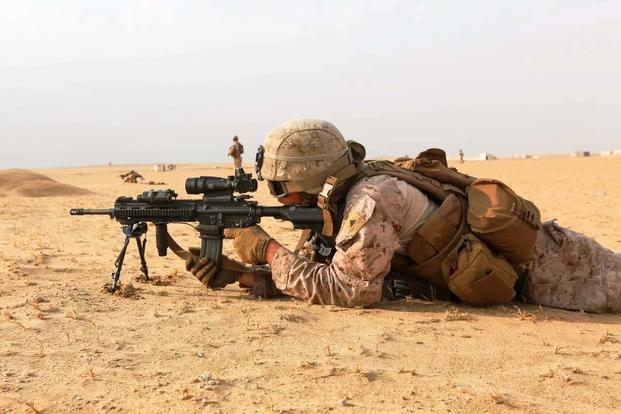LAS VEGAS -- The Marine Corps is getting ready to place a big order for the Heckler & Koch M27 rifle. But the sticker shock might not be as bad as some feared.
In December, Marine Commandant Gen. Robert Neller confirmed to Military.com that the service plans to equip each member of the infantry squad, and possibly other infantry support elements, with the M27 infantry automatic rifle.
The 5.56mm rifle, based on the HK 416, has been used by automatic rifle Marines since 2010.
But the recent move, designed to make the rifle squad more flexible and deadly, will see the M27 in the hands of a much larger proportion of the infantry community.
Related content:
- OSS Aims to Woo Marines With One-Piece Baffleless Suppressor
- Springfield Armory Hopes Women Will Notice Its New Concealable Pistol
- Check Out Military.com's coverage of SHOT Show 2018
While the Marine Corps has not yet inked a contract for the weapons or confirmed how many it plans to buy, it stands to benefit from the recent popularity of the HK 416 design.
Robert Reidsma, who manages the infantry assault rifle (IAR) program for HK, told Military.com on Tuesday at SHOT Show that the French military had recently contracted with the company for 100,000 HK 416 variant rifles over the next 10 years, to replace its current infantry FAMAS rifle.
The German special forces are also picking up a variant of the rifle; it was announced last October that Germany planned to buy some 1,745 of the HK 416 A7 model, which it will rename the G95.
"It's good from a business standpoint. It's the same raw material, with little differences with what's going on it," Reidsma said. "That helps us from a production standpoint."
Price had previously been a sticking point for the Marine Corps when it came to the M27; it's frequently quoted as costing roughly $3,000 per rifle, as opposed to the current M4 carbine, which costs closer to $1,000.
Reidsma said the M27 never actually cost quite that much -- contracts that included spares and services made the price seem higher -- but added that the Corps is poised to get a much better deal this time around.
"With all the other 416 programs going on right now, it helps to mitigate some of that cost," he said.
Other factors that will contribute to bringing the cost down include a better current Euro-to-dollar exchange rate (HK is headquartered in Germany) and the larger expected size of the Corps' order.
Reidsma declined to say what the estimated unit cost is expected to be, but said it represented a significant reduction.
"Obviously, they want a bigger quantity and the economies of scale have changed," he said. "I think it's one of the most affordable prices I've seen for the capability they're getting."
The company is currently able to produce anywhere from 300 to 1,500 M27s a month to meet the service's requirements, Reidsma said.
While contract solicitations from the past year indicate the Marine Corps wants to purchase the IAR as-is, Reidsma said HK stands ready to modify the weapon if asked to do so.
"Higher magazine capacity, a shorter barreled system ... of course, there's the acquisition process to go through, the requirements process, testing and validation," he said. "Would [the Marine Corps] be able to change a whole lot of stuff? I don't know. Would it drive up that price point? Theoretically, it could."
From field testing, Reidsma said it's clear Marine infantrymen have enjoyed testing out the M27, which boasts improved accuracy and reliability over the M4.
"For me, it was like Christmas morning or something," said Reidsma, a retired Marine. "The stories, the confidence level -- you just hear it over and over. It's like, wow. We're absolutely stoked the Marine Corps would like to move forward and get more of them, because it's a huge capability for them."
-- Hope Hodge Seck can be reached at hope.seck@military.com. Follow her on Twitter at @HopeSeck.










